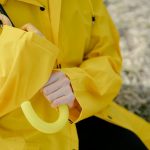Picture yourself caught in a sudden downpour, your gear protecting you from the relentless rain. Understanding hydrostatic head ratings in waterproof fabrics is essential for choosing the right equipment for your outdoor adventures. These ratings indicate how much water pressure a fabric can withstand before it starts to leak. So, what do those numbers really mean, and how can they impact your next outing? Let’s break it down.
Table of Contents
Key Takeaways
- Hydrostatic head ratings measure a fabric’s resistance to water pressure, with higher ratings indicating better waterproofing capabilities.
- Ratings of 1,500mm to 5,000mm are suitable for light rain and everyday use, while 5,000mm to 10,000mm is ideal for moderate to heavy rain.
- Fabrics rated over 10,000mm are designed for extreme weather conditions, offering superior protection during unpredictable weather.
- The fabric type, weave tightness, and coatings significantly influence hydrostatic head ratings and overall waterproof performance.
- Proper selection based on activity and environmental conditions ensures optimal protection and enhances outdoor experiences.
What Is Hydrostatic Head and How Is It Measured?
Hydrostatic head refers to the pressure exerted by a column of water, and it’s an essential factor in determining the waterproofing effectiveness of materials.
You measure it by calculating the height of the water column that a fabric can withstand before leaking. Typically, this is done using a hydrostatic head test, where you apply water pressure to the fabric until it begins to seep through.
The height of the water column is measured in millimeters, and a higher rating indicates better waterproofing capabilities. For instance, a fabric with a rating of 5,000 mm can resist pressure from a 5-meter tall column of water.
Understanding these ratings helps you choose the right materials for your outdoor gear or construction projects.
Interpreting Hydrostatic Head Ratings
How do you make sense of hydrostatic head ratings when choosing materials for your gear?
Start by understanding that a higher rating generally indicates better waterproofing. Ratings are measured in millimeters, showing how much water pressure a fabric can withstand before leaking. For instance, a fabric with a rating of 1,500mm can resist the pressure of 1.5 meters of water.
Consider your activities; if you’re hiking in light rain, a lower rating might suffice. However, for heavy downpours or extreme conditions, opt for materials rated 5,000mm or higher.
Keep in mind that hydrostatic head is just one factor; breathability and durability are also essential. Balancing these aspects will help you make an informed choice for your gear.
Different Categories of Hydrostatic Head Ratings
When selecting gear, it’s vital to recognize that hydrostatic head ratings fall into different categories, each suited for specific conditions and activities.
Understanding hydrostatic head ratings is essential for choosing the right gear for your outdoor adventures.
Generally, fabrics with a rating of 1,500mm to 5,000mm are ideal for light rain and everyday use. For moderate to heavy rain, look for ratings between 5,000mm and 10,000mm, which provide better protection during outdoor adventures.
If you’re venturing into extreme conditions, you’ll want fabrics rated over 10,000mm, offering maximum waterproof performance.
Each category caters to specific weather scenarios, so it’s important to choose based on your planned activities.
Applications of Hydrostatic Head Ratings in Outdoor Gear
Understanding the applications of hydrostatic head ratings in outdoor gear can greatly enhance your experience in various weather conditions.
When you’re choosing rain jackets, tents, or pants, knowing the hydrostatic head rating helps you select gear that’ll keep you dry. A higher rating indicates better waterproofing, which is essential for extended exposure to heavy rain or wet environments.
For instance, if you’re hiking or camping in unpredictable weather, gear with a rating of 10,000 mm or more is ideal for staying dry. Conversely, for light drizzles, a lower rating might suffice.
Factors Influencing Hydrostatic Head Ratings
Selecting outdoor gear based on hydrostatic head ratings involves more than just picking a number; various factors influence these ratings.
First, the fabric type plays an essential role. Materials like nylon or polyester can differ greatly in water resistance.
Next, the weave tightness affects how much water pressure the fabric can withstand.
Additionally, the presence of coatings or laminations, such as Gore-Tex, enhances performance but may change breathability.
Environmental conditions, including temperature and humidity, also impact a fabric’s effectiveness.
Finally, the fabric’s age and care can alter its hydrostatic head rating over time.
Understanding these factors helps you make informed choices when selecting waterproof gear for your outdoor adventures.
Comparing Hydrostatic Head With Other Waterproof Metrics
While hydrostatic head ratings are essential for evaluating waterproof capabilities, they don’t tell the whole story.
To get a complete picture of a fabric’s waterproofness, you should consider these other metrics:
- Breathability: This measures how well moisture vapor escapes, preventing you from feeling clammy inside the garment.
- Seam Sealing: Even the best materials can leak at the seams, so effective seam sealing is vital for overall waterproof performance.
- Water Resistance: This refers to the fabric’s ability to repel water initially, which can influence its performance in light rain before the hydrostatic head kicks in.
Frequently Asked Questions
How Do I Choose the Right HH Rating for My Activities?
Choosing the right HH rating depends on your activities. If you’re hiking in heavy rain, aim for higher ratings. For casual outings, lower ratings might suffice. Consider your typical weather conditions and duration of exposure.
Can HH Ratings Change Over Time With Use?
Yes, HH ratings can change over time, much like a car’s performance can fade with wear. As you use your waterproof fabric, factors like abrasion and exposure to elements can impact its effectiveness.
What Are the Best Materials for High HH Ratings?
For high hydrostatic head ratings, you’ll want to look for materials like Gore-Tex, eVent, or proprietary waterproof fabrics. These materials excel in water resistance, durability, and breathability, making them ideal for outdoor gear.
Are HH Ratings Affected by Washing or Cleaning Products?
Yes, washing and cleaning products can affect HH ratings. They may break down the fabric’s waterproofing treatment, leading to reduced performance. To maintain effectiveness, you should follow care instructions and opt for suitable cleaning products.
How Do Temperature and Humidity Impact Waterproof Performance?
Temperature and humidity greatly influence waterproof performance. Higher temperatures can weaken materials, while increased humidity may reduce breathability. You should always consider these factors when choosing gear for various weather conditions to guarantee ideal protection.
- Does Chiffon Fabric Stink - July 15, 2025
- Does Chiffon Fabric Affect the Economy - July 15, 2025
- Does Cotton Fabric Have a Nap - July 15, 2025






